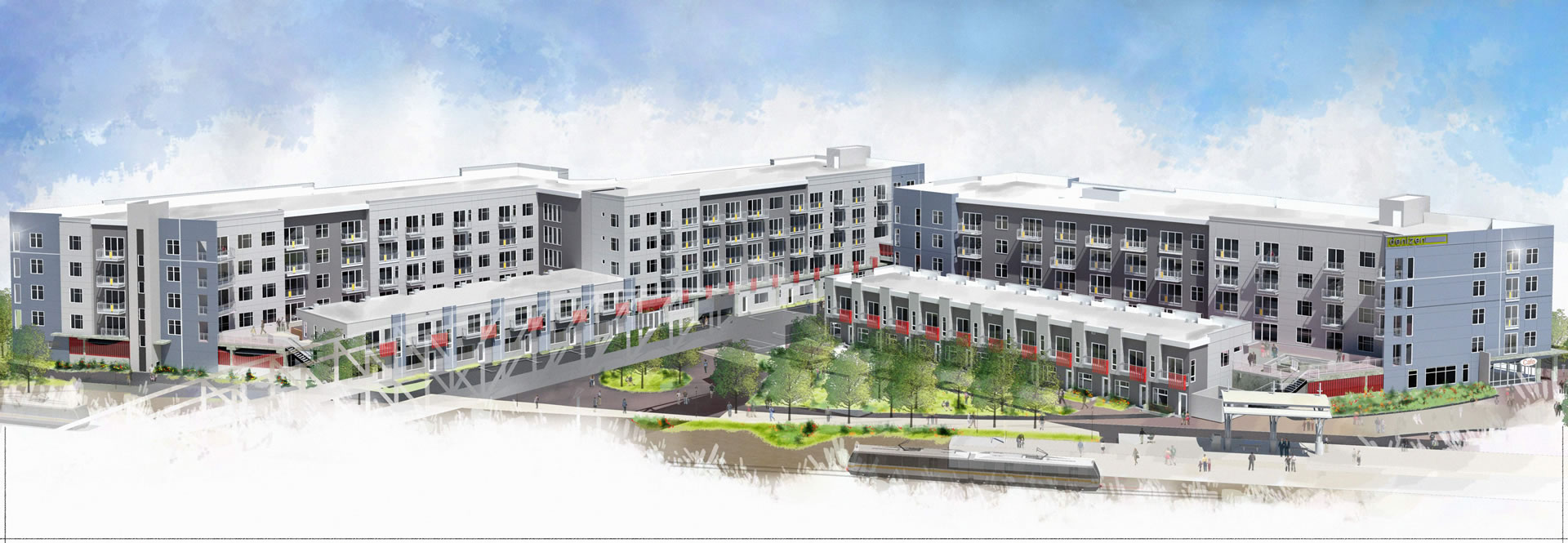Until recently, there was little resembling a neighborhood to see while looking down from the sky at the area around Alameda Station, a light-rail stop two-and-a-half miles south of the state capitol building in downtown Denver. About half of the 75-acre triangle between South Broadway, West Alameda Avenue, and the tracks is parking for the large retailers who make up the other half. D4 Urban, a local development company specializing in urban infill projects, is starting to change that with two interrelated projects that, in the words of D4 development manager Dan Cohen, will “bring the area from an auto-oriented big-box retail configuration to a high-density, mixed-use arrangement”: the Denizen multifamily development at Alameda Station and the Dakota Outfall Project public infrastructure installation. Cohen walks us through the plan.
BUILT BY TRANSIT
After securing development rights to 68 of the 75 acres of asphalt and big-box rooftops, D4 generated an alternative vision of a much more livable neighborhood. Entitlements allow for a potential 10 million square feet of live-work-play space with a hefty amount of green space left over. As a decidedly transit-oriented development, the first phase involves replacing the three-acre park-and-ride lot at Alameda Station with a 275-unit residential complex, billed simply as Denizen, currently under construction.
SHARING ECONOMIES
Denizen will be the first LEED Platinum pearl in the planned LEED-ND neighborhood, but green materials and energy efficiency were simply starting points for the design, not the ultimate goal. “We think this development is going to attract a lot of people that don’t own a car,” says Cohen, explaining D4’s overarching design directive for the project. The district will be a confluence of bus lanes, bike lanes, and rail lines, featuring bike- and car-sharing programs and shared community garden spaces. It’s designed for Denver’s hip, socially and environmentally conscious demographic, a crowd that is big on small carbon footprints and prefers in-town rentals to the white picket fences of the suburbs.
PROJECT
LOCATION Denver
Program Mixed-use development
Size 75 acres
Completion 2015 (expected)
Certification LEED Platinum (for Denizen, expected), LEED-ND (for development, expected)
TEAM
OWNER D4 Urban
Architect Kephart
Civil Engineer S.A. Miro
General Contractor CFC, PCL (joint venture)
Landscape Design Studio Insite
LEED Certification US Eco-Logic
Legal Counsel McGeady Sisneros
ACCESS AND AFFORDABILITY
Tenants at Denizen can choose from 360-square-foot efficiencies, 1,200-square-foot townhomes, and several floor plans in between, all at competitive market rates expected to average below $2 per square foot upon delivery in July 2015. The development’s Walk Score is 89 out of 100, and the parking-to-dwelling ratio is a modest one-to-one. “We’ve unbundled parking from rent to help reduce gross occupancy costs,” Cohen says. With the menu of housing and transit options, walkability, and a building envelope and HVAC system that will keep utility bills to a minimum, Denizen seems destined to become a magnet for budget-minded millennials.
A STORMWATER SOLUTION
Though the Denizen site faces the rail station on one side, the other side meets with the back wall of a K-Mart and associated inline retail, blocking access from Dakota Street, which dead-ends in the parking lot on the other side of the store. With all those impervious acres in the Platte River bottomlands, flooding has been a perennial problem in the adjoining neighborhoods, posing another significant challenge. D4 unraveled both roadblocks with a single solution: the Dakota Outfall Project, a combination of drainage infrastructure and gateway streetscape. The plan will extend Dakota Avenue through the K-Mart and inline retail site to Alameda Station, routing stormwater along with it, under the tracks and out to the river.
PUBLIC-PRIVATE POLITICS
Purely from a design perspective, the Dakota Outfall plan made perfect sense. However, its $21.5 million price tag—as well as its need to relocate three retail tenants and build a new public street—made it a fiscal and political challenge for the developers. “We knew we had to have a public purpose to move tenants around and tear out about 8,000 square feet of retail,” Cohen says. Fortunately, civic leaders adopted the Dakota Outfall as a solution to the city’s larger flooding issues and contributed $18 million towards the infrastructure project that now collects runoff from 1,700 flood-prone acres of central Denver. The resulting public-private partnership enabled the use of eminent domain to rearrange the existing urban fabric.



